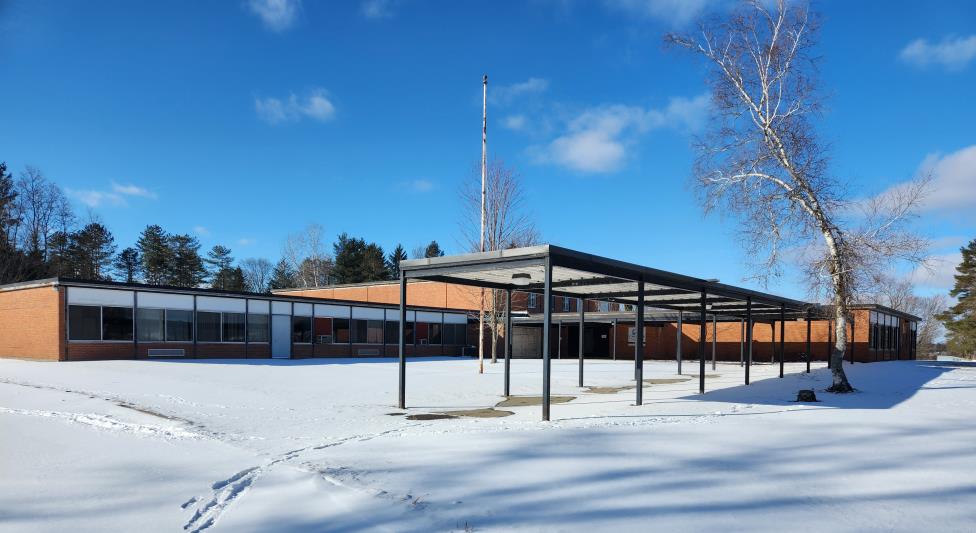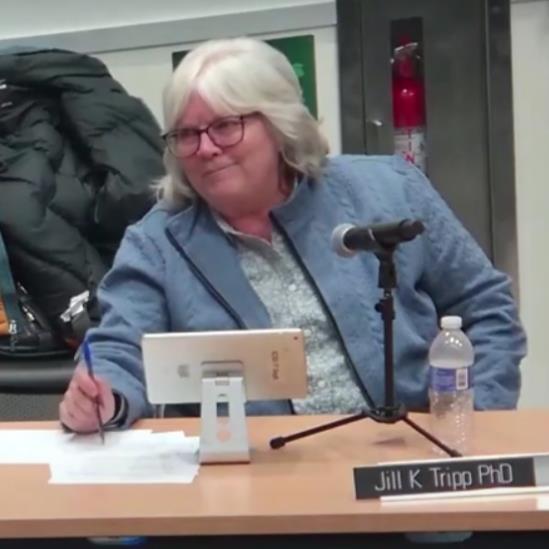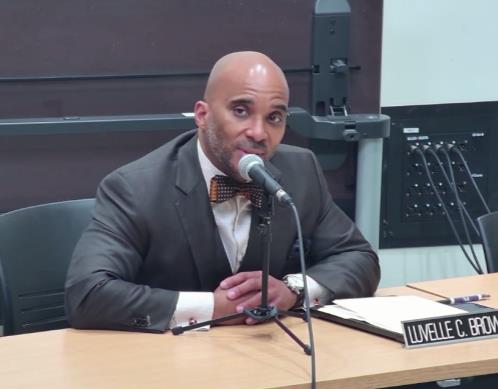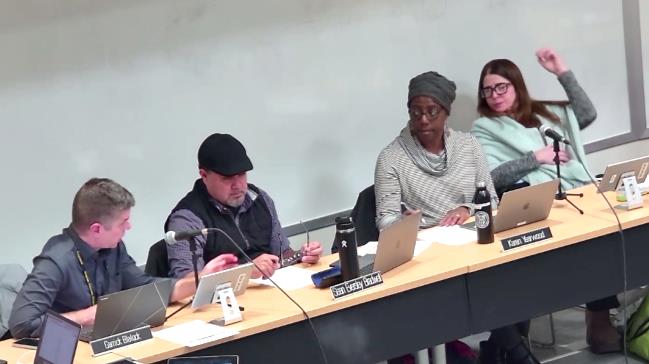ICSD Board scours for funds in newly-found places

by Robert Lynch; February 2, 2025
It could prove as futile as searching for lost change under the couch. Then, again, it could still prove worthwhile if you’re looking for it in the living room mansion of Ithaca’s rich Uncle Ezra. That quest for extra cash from Ithaca’s most opulent employer was what drove the Ithaca Board of Education as it invested nearly an hour of its time last Tuesday night pursuing both new revenue sources and potential cost savings.
“This isn’t something we can control,” Board member Jill Tripp cautioned colleagues at the outset of members’ lengthy discussion over whether the Ithaca City School District could entice, persuade—but probably never compel—Cornell University to contribute more than its current $650,000 annually toward underwriting the ICSD’s yearly budget, now approaching $170 Million.
“We can’t control whether it happens, and it would require negotiations and possibly a campaign to engage Cornell in the negotiations,” Tripp, one of the ICSD’s most taxpayer-conscious board members, conceded.
Jill Tripp chairs the “Revenue Generation Advisory Council,” created last year as the Ithaca School Board struggled with financial challenges complicated by overwhelming voter rejection of its first-submitted district budget. The request for an “increased donation from Cornell University” was but one of four revenue-enhancing options Tripp presented the Board of Education January 28th for its review.
The council’s other three options included: 1) the sale or lease of district property; 2) enactment of an excise tax on utilities; and 3) reducing costs by “closing school buildings” or sharing services and expenses through “consolidation” with neighboring school districts.

At the discussion’s outset, Tripp had sought a straw poll to gauge members’ relative support. She never really got one, at least nothing equating to a rise of hands. What came forth, instead, was random praise or criticism as each option was discussed one by one.
Evident to any observer, the reconsideration of a utility tax—last contemplated around 2019 and 2020, but then rejected as a revenue generator—drew the least support. Sale or lease of surplus land or buildings brought measured acceptance. But leaning more heavily on Cornell, the revenue source holding the largest financial windfall for local schools, drew the evening’s predominant focus.
Employ a time management technique as a benchmark for interest. Members debated seeking a heightened university contribution for a full half-hour. Sale or lease of buildings warranted just eight minutes’ discussion; the utility tax, ten; closings and consolidation, only five.
“This is actually my favorite option,” Tripp said of the Ithaca district shedding itself of unused buildings and the under-utilized land that surrounds some of the structures still needed. Board president Dr. Sean Eversley Bradwell, in particular, mentioned as a candidate the mothballed Danby Elementary School, which hasn’t taught a kid since maybe the late-1970’s, . Eversley Bradwell also referenced the “17-20 acres” adjacent to Enfield Elementary School.
“I like the idea of a slimmer operation where it’s possible and where it increases efficiency, so that’s my take,” Tripp said in favor of intelligent offloads.
Yet some members grew hesitant. No one called for a vote. And on the prospect of property liquidation, consensus directed members toward first seeking a study into where the school system will grow, where it will shrink, and how the district’s approximately 20 structures would fit into that vision.
Í don’t feel comfortable doing a straw poll at this point because there’s still some missing links here with all of these,” Board member Karen Yearwood cautioned.
The council’s second option, a utility tax on communication services and maybe other utilities, served as a destined-to-reject alternative raised seemingly only for the purpose of knocking it down. Those with long memories recalled public resistance when the idea was last broached near the turn of the decade.
A utility tax “would be very unpopular with our community,” Tripp admitted. “Nobody likes to hear about new taxes,” she said.
“This came up in my six-year tenure, and it’s really contentious,” Erin Croyle remembered. “I don’t think it would be very popular, and it’s a regressive tax,” Croyle stated.
A utility tax supposedly spreads the school funding burden beyond the property owner. Some taxpayers may like that idea. And it could raise a half-Million to $2 Million a year. Tripp claimed that perhaps 40 school districts in the state impose such a tax. The tax might raise monthly bills by 2.5 to 7.5 per cent.
But critics like Croyle maintain a utility tax places disproportionate burden on the less-affluent. And renters still pay hidden school taxes through the rent checks they write, she asserted. A cell phone tax, to Croyle, becomes a “double tax.”
“I don’t hear anyone screaming out for additional exploration,” Jill Tripp said of the utility tax option. “It’s unpopular for a reason, and I don’t see any point for us to pursue it at this point.”
Board President Eversley Bradwell qualified that he favored “exploring” the utility tax option, but only to “gather more information.” The evening’s discussion moved on.
Cornell University’s current annual gift to the Ithaca City School District, $650,000, as anyone could plausibly postulate that night, compensates the ICSD for educating the children of graduate students who reside in tax-exempt university housing. That rationale may or not be true. But Tripp’s Advisory Council would like to raise support much higher, perhaps to $10 Million a year. Cornell’s critics assert it’s a level more in line with what other Ivy League universities pay.
But asking is not receiving. And much of the time board members consumed Tuesday involved plotting strategy. Should the ICSD seek only a continued “voluntary contribution” or press for a legally-enforceable contract? And to achieve either, how best could the district proceed?
“Not all money is good money,” School Superintendent Dr. Luvelle Brown reminded the board, recalling his father’s advice.

“When I see a number like $10 Million, and if it’s going to be a ‘voluntary contribution,’ we need to know that that could go away one day pretty quickly, and then what does that leave our folks?” Brown asked.
Dr. Brown recommended a negotiated agreement, one that reduces uncertainty and establishes binding expectations.
“When folks give you this kind of money, they’re going to ask for something in return,” the Superintendent cautioned. “So what is it that we’re prepared to give up?” he questioned.
Of any member of the Ithaca Board of Education, Garrick Blalock—himself a Cornell professor—assigned to the university that night the most uncompromising transactional greed. To Blalock, Cornell acts only out of hard-hearted self-interest, never kind-spirited altruism.
“I don’t think there’s a sentiment at Cornell that a voluntary contribution is something it should or will do above what they see as their direct receipt of services,” Blalock predicted.
“They don’t pay the City of Ithaca to be nice, because they want the City to prosper per se” Blalock stated bluntly. Rather, it’s “because every time someone pulls a fire alarm in one of the Cornell dormitories, a city truck rolls out. There’s a cost associated with that, and the voluntary payment is meant to be in response to service provided,” Blalock reasoned.
Well, sort of. Reporting memory bends that argument even further in a transactional direction. Under a 2023-renegotiated, inflation-adjusted, multi-year agreement, Cornell currently pays the City of Ithaca $4 Million a year. And for two decades before that, the annual payment was $1.6 Million. Why Cornell paid Ithaca anything at all, memory has it, was that Ithaca held Cornell over a barrel. The city reportedly threatened not to sign off on campus building permits unless it was handsomely compensated. The ploy worked.
But the Ithaca City School District cannot refuse to educate grad students’ kids. So any comparable leverage for the ICSD is lost. Or is it?
Cornell needs to attract and retain top academic talent, Blalock brought to everyone’s attention. No alternative private school exits. So pure self-interest, he said, should motivate the university to prop up Ithaca’s public schools as a hiring incentive.

“So the idea of some zero-sum money flowing from the top of the hill to the bottom of the hill, I just don’t think is maybe the best approach to this,” Blalock told board colleagues. “I’d move away from words like ‘donation,’ and look towards like ‘shared success,’ and try to engage Cornell in a collaborative discussion that would raise both boats.”
Erin Croyle countered that Cornell should not just consider its highly-paid professors, but also its lesser-rewarded staff; “the people at the bottom of the hill historically getting the scraps from the castle,” she analogized.
“I think it would be a really beautiful thing if Cornell could also consider all the other employees that work here, whose children go to school here, who are struggling to get by and buy them soccer cleats,” Croyle said. Increased university contribution, she concluded, would help “take a load off of the community” for people like them.
But Blalock put himself in the Board of Trustees’ position: “Our job is not to do X, Y, and Z,” he said. “Our job is to further the objectives of the university.” That’s why, to Blalock, a self-interest incentive would sell best to decision-makers on East Hill.
“That (it) will have more traction,” Croyle recognized, “It doesn’t mean that it’s right.”
Now, how the proceed: Board members that night initially tasked Superintendent Brown to contact university administrators. One or more board members may eventually join him. By the Superintendent’s preference, the effort will likely seek a commitment that’s binding. Blalock even suggested enlisting persuasive muscle through an appeal to the Faculty Senate.
“We’ve got a plan,” Jill Tripp concluded. “We’ll come back with the specifics and Dr. Brown will continue to share his thoughts about who he wants with him and how we might go about this.”
****
“Gosh, it’s getting late,” Tripp said as the clock passed Nine and her four-point presentation finally wound down. And because of that presumed collective fatigue, board members spent little effort analyzing the most sweeping—yet challenging—alternative of all: consolidation and redistricting.

Disruptive it would be. Tripp admitted it. And perhaps to stay on the safe side of controversy, her PowerPoint slide and the discussion surrounding it never wandered from generalities to specifics. Consolidation could shutter an additional building or two. And “regionalization,” as some termed it, could “reduce costs by sharing services (and/or) costs of programs and administration with neighboring school districts”
New York State likes such things, board members acknowledged. But those living or running schools within Ithaca or its adjacent districts could have a tough time of it.
“I am clearly against the idea of consolidation,” Board President Eversley Bradwell asserted. “With that being said, I am not against doing research… to figure out what the feasibility is, and it’s probably time for a feasibility study.”
Were “regionalization” to come about, the Board President predicted, the Ithaca schools would likely become the region’s “hub.”
Closing more schools like long-vacant Danby’s or farming out tasks to places like Trumansburg or Newfield stood clearly beyond what the Ithaca School Board chose to put on its plate last Tuesday night. Whatever might come later will surface in the months ahead.
But in any school district’s incremental, sluggishly slow, yet progressive evolution, change blossoms from tiny seeds planted during discussions that some might find too boring to assign much weight. Wrong they’d be. If Cornell is to cough up more money, or if a building or two is to be listed with Warren Real Estate, Jill Tripp’s presentation from the Revenue Generation Advisory Council during an otherwise dull meeting in the last week of January is where those initiatives began. Watch for next steps.
###

